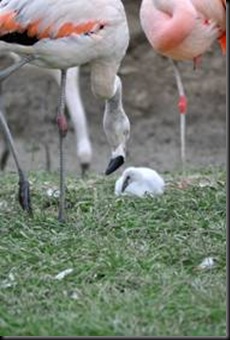PRESS RELEASE
CHILEAN FLAMINGO CHICKS HATCH AT SEAVIEW WILDLIFE ENCOUNTER, ISLE OF WIGHT
Chilean Flamingos (Phoenicopterus chilensis) are ‘near threatened’ in the wild and do not breed readily in captivity. Seaview Wildlife Encounter on the Isle of Wight is proud to announce that their healthy, well-established flock has once again produced chicks! Three have hatched in the last few days. Two are still on their nests, whilst the oldest of the three - now all of four days old - is already on its feet and wandering in amongst the adult birds.
Image left shows two adult Chilean Flamingos incubating their eggs on hard mud ‘nests’ at Seaview Wildlife.
In the wild Chilean Flamingos are found in South America where they inhabit muddy, shallow lakes that are either alkaline or brackish. The soil surrounding the lakes is usually desert-like and barren of vegetation. Their breeding colonies can contain thousands of birds and after courtship rituals of synchronized dancing, preening, neck stretching and honking they mate during April and May.
Images right and below show Chilean Flamingo chick at Seaview Wildlife aged four day (27 July 2011).
The female lays one chalky white egg on a mud mound in shallow water. The nests are usually built about 1.5 m (4.9 ft) apart so that each chick is safe from neighbouring nests – parent birds are territorial during the breeding season. Both parents share in the incubation of their egg for 27 - 31 days after which time a small white fluffy chick emerges.
For the first few days after hatching the parent birds both feed the chick a substance called "crop milk" from their upper digestive tract. Other Flamingos can sometimes act as foster feeders. At the age of about one week the chicks gather together in crèches that are watched over by a few adult birds. As they grow, the chicks’ white baby plumage is gradually taken over by larger, grey feathers. Their beautiful Pink feathers only start to appear when they are nearly a year old and it’s only at 3 – 4 years of age when the Flamingos reach sexual maturity that they have their full adult plumage.









No comments:
Post a Comment